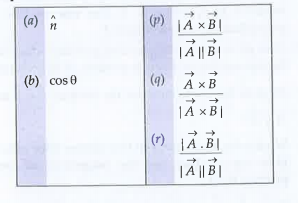Which of the following operations between the two vectors can result a vector perpendicular to either of them ?
Addition
Subtraction
Product
Division
The correct Answer is:3
Step by step video, text & image solution for Which of the following operations between the two vectors can result a vector perpendicular to either of them ? by Maths experts to help you in doubts & scoring excellent marks in Class 12 exams.
Topper's Solved these Questions
- BOOK - AAKASH INSTITUTECHAPTER - VECTOR ALGEBRAEXERCISE - ASSIGNMENT (SECTION-B)32videos
VECTOR ALGEBRA
- BOOK - AAKASH INSTITUTECHAPTER - VECTOR ALGEBRAEXERCISE - ASSIGNMENT (SECTION-C)6videos
VECTOR ALGEBRA
- BOOK - AAKASH INSTITUTECHAPTER - VECTOR ALGEBRAEXERCISE - TRY YOURSELF20videos
VECTOR ALGEBRA
- BOOK - AAKASH INSTITUTECHAPTER - TRIGNOMETRIC FUNCTIONS EXERCISE - Section - J (Akash Challengers Question)15videos
TRIGNOMETRIC FUNCTIONS
Similar Questions
Knowledge Check
- Question 1 - Select One
If a is vector perpendicular to both b and c them
Aa + ( b + c) = 0Ba×(b+c)=0Ca×(b×c)=0Da⋅(b×c)=0 - Question 2 - Select One
For what angle between the two vectors, their resultant is maximum?
A180∘BzeroC90∘D45∘ - Question 3 - Select One
Assertion: The scalar product of two vectors can be zero
Reason: If two vectors are perpendicular to each other their scalar product will be zero.AIf both assertion and reason are true and reason is the correct explanation of assertion.BIf both assertion and reason are true but reason is not the correct explanation of assertionCIf assertion is true but reason is false.DIf both aseertion and reason are false.
Which of the following vectors is/are perpendicular to the vector 4ˆi+3ˆj?
View SolutionState parallelogram law of vector addition. Find analytically the magnitude and direction of resultant vector. Apply it to find the resultant when,
(i) Two vectors are parallel to each other
(ii) Two vectors are perpendicular to each otherView SolutionWhich of the following vectors is//are perpendicular to the vector 4I−3j ?
View SolutionTwo equal vectors have a resultant equal to either of them. The between them is
View SolutionThe resultant of two vectors →Aand→B is →C. If the megnitude of →B is doubled, the new resultant vector becomes perpendicular to →A, then the magnitude of →C is
View Solution


